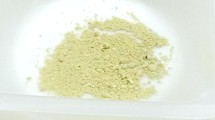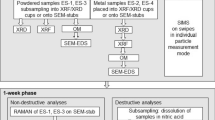Abstract
Nuclear forensic science has become increasingly important for global nuclear security, and enhancing the timeliness of forensic analysis has been established as an important objective in the field. New, faster techniques must be developed to meet this objective. Current approaches for the analysis of minor actinides, fission products, and fuel-specific materials require time-consuming chemical separation coupled with measurement through either nuclear counting or mass spectrometry. These very sensitive measurement techniques can be hindered by impurities or incomplete separation in even the most painstaking chemical separations. High-temperature gas-phase separation or thermochromatography has been used in the past for the rapid separations in the study of newly created elements and as a basis for chemical classification of that element. This work examines the potential for rapid separation of gaseous species to be applied in nuclear forensic investigations. Monte Carlo modeling has been used to evaluate the potential utility of the thermochromatographic separation method, albeit this assessment is necessarily limited due to the lack of available experimental data for validation.










Similar content being viewed by others
References
Hanson DE, Garrison JR, Hall HL (2011) Assessing thermochromatography as a separation method for nuclear forensics: current capability vis-à-vis forensic requirements. J Radioanal Nucl Chem 289(1):213–223
Zvara I (1985) Simulation of thermochromatographic processes by the Monte Carlo method. Radiochim Acta 38(2):95–101
Yakushev A et al (2003) Thermochromatographic studies of berkelium chlorides: BkCl3 and BkCl4. Radiochim Acta 91(3):123–126
Eichler B, Eichler R (2003) Gas-phase adsorption chromatographic determination of thermochemical data and empirical methods for their estimation. In: Schadel M (ed) The chemistry of the superheavy elements. Kluwer Academic Publishers, Darmstadt, pp 205–235
Chapman S, Cowling TG (1990) The mathematical theory of non-uniform gases: an account of the kinetic theory of viscosity, thermal conduction and diffusion in gases, 3rd edn. Cambridge University Press, Cambridge
Atkins P, Paula Jd (2002) Physical chemistry, 7th edn. W.H. Freeman and Company, New York
Eichler B, Kratz JV (2000) Radiochem Acta 88
Fan W, Gaggeler H (1982) Thermochromatography of carrier-free lead in quartz columns with hydrogen and argon as carrier gases. Radiochim Acta 31(1–2):95–97
Chuburkov YT et al (1995) Entropy and enthalpy of adsorption of gaseous metal chlorides and oxychlorides on quartz glass as functions of adsorbate composition. Radiochemistry 37(6):488–496
Dienstbach F, Bachmann K (1983) Gas-solid thermochromatographic separation of lanthanide chlorides. Radiochim Acta 34(4):215–217
Eichler B (1996) The behavior of radionuclides in gas adsorption chromatographic processes with superimposed chemical reactions (chlorides). Radiochim Acta 72(1):19–26
Hohn A, Eichler R, Eichler B (2004) Investigations on adsorption and transport behaviour of carrier-free silver gold and platinum in quartz columns under vacuum conditions. Radiochim Acta 92(8):513–516
Gaggeler H et al (1986) Vacuum-thermochromatography of carrier-free species. Radiochim Acta 40(3):137–143
Author information
Authors and Affiliations
Corresponding author
Rights and permissions
About this article
Cite this article
Garrison, J.R., Hanson, D.E. & Hall, H.L. Monte Carlo analysis of thermochromatography as a fast separation method for nuclear forensics. J Radioanal Nucl Chem 291, 885–894 (2012). https://doi.org/10.1007/s10967-011-1367-5
Received:
Published:
Issue Date:
DOI: https://doi.org/10.1007/s10967-011-1367-5




